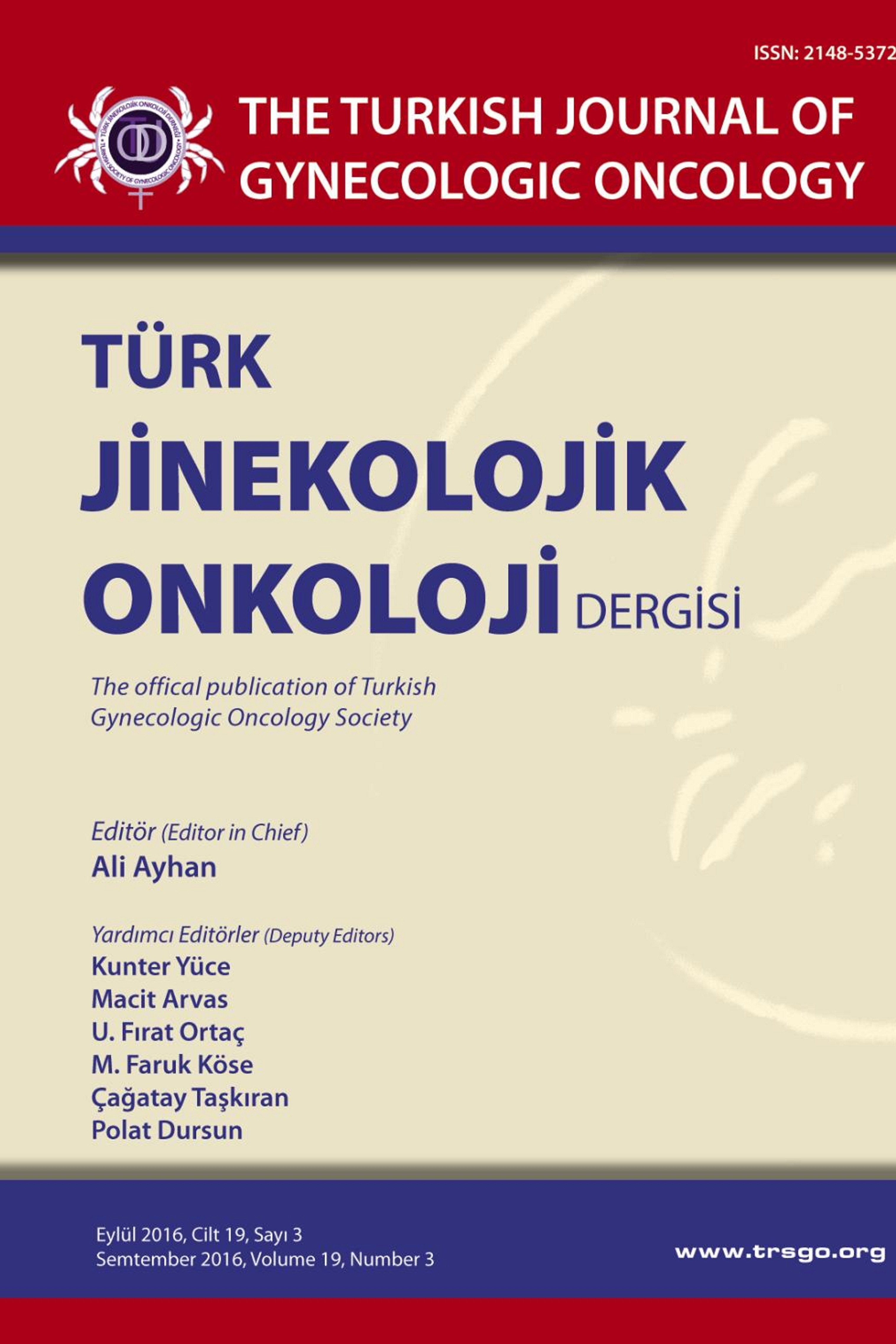ROBOTİK RADİKAL PARAMETREKTOMİ, PELVİKLENFADENEKTOMİ, VAJEN 1/3 ÜST KISMININ ÇIKARILMASI:OLGU SUNUMU
Robotik Cerrahi, Radikal Parametrektomi, Serviks Kanseri, Eksik Cerrahi
ROBOTİK RADİKAL PARAMETREKTOMİ, PELVİKLENFADENEKTOMİ, VAJEN 1/3 ÜST KISMININ ÇIKARILMASI:OLGU SUNUMU
___
- 1. Zapardiel I, Zanagnolo V, Magrina JF, Magtibay PM. Robotic radical parametrectomy in cervical cancer. Gynecol Obstet Invest 2011;72:179-182.
- 2. Ramirez PT, Schmeler KM, Wolf JK, Brown J, Soliman PT. Robotic radical parametrectomy and pelvic lymphadenectomy in patients with invasive cervical cancer. Gynecol Oncol 2008;111:18-21.
- 3. Leath CA 3rd, Straughn JM, Bhoola SM, Partridge EE, Kilgore LC, Alvarez RD. The role of radical parametrectomy in the treatment of occult cervical carcinoma after extrafascial hysterectomy. Gynecol Oncol 2004;92:215-219.
- 4. Magrina JF, Zanagnolo VL. Robotic surgery for cervical cancer. Yonsei Med J 2008;49:879-885.
- 5. Suh DH, Chung HH, Kim JW, Park NH, Song YS, Kang SB. An occult invasive cervical cancer found after a simple hysterectomy: a 10-year experience in a single institution. Int J Gynecol Cancer 2011;21:1646-1653.
- 6. Vitobello D, Siesto G, Bulletti C, Accardi A, Iedà N. Robotic radical parametrectomy with pelvic lymphadenectomy: our experience and review of the literature. Eur J Surg Oncol 2012;38:548-554.
- 7. Wright JD, Grigsby PW, Brooks R et al. Utility of parametrectomy for early stage cervical cancer treated with radical hysterectomy. Cancer 2007;110:1281-1286.
- 8. Yim GW, Kim SW, Nam EJ, Kim YT. Role of robot-assisted surgery in cervical cancer. Int J Gynecol Cancer 2011;21:173-181.
- 9. Gori JR, Fritsches HG, Castanño R, Toziano M, Habich D. Radical parametrectomy for occult cervical carcinoma detected posthysterectomy. J Low Genit Tract Dis 2004;8:102-105.
- 10. Chi DS, Abu-rustum NR, Hoskins WJ. Cancer of the Cervix. In:Rock JA, Jones HW (eds). Te Linde’s Operative Gynecology. Lippincott Williams & Wilkins. Philadelphia, USA, 2003; 1373-1444.
- 11. Gadducci A, Tana R, Cosio S, Cionini L. Treatment options in recurrent cervical cancer (Review). Oncol Lett 2010;1:3-11.
- 12. Park JY, Kim DY, Kim JH, Kim YM, Kim YT, Nam JH. Management of occult invasive cervical cancer found after simple hysterectomy. Ann Oncol 2010;21:994- 1000.
- 13. Yim GW, Kim YT. Robotic surgery in gynecologic cancer. Curr Opin Obstet Gynecol 2012;24:14-23.
- ISSN: 2148-5372
- Başlangıç: 2014
- Yayıncı: Türk Jinekolojik Onkoloji Derneği
JİNEKOLOJİK VE JİNEKO-ONKOLOJİK CERRAHİDE VENÖZ TROMBOEMBOLİZM PROFİLAKSİSİ
Ümran KÜÇÜKGÖZ GÜLEÇ, Ahmet Barış GÜZEL, Süleyman Cansun DEMİR, Mehmet Ali VARDAR, Aytekin ALTINTAŞ
Bülent ÖZDAL, Sevgi AYHAN, Eralp BAŞER, Oğuz Devrim YARDIMCI, Levent ŞİRVAN, Tayfun GÜNGÖR
Dimitrov GO, Dimitrov GL, Dzikova E, Panov S, Ceselkovska M, Babusku GJ
Müjdegül ZAYIFOĞLU KARACA, Cihan TOĞRUL, Eralp BAŞER, Bülent ÖZDAL, Tayfun GÜNGÖR
ROBOTİK RADİKAL PARAMETREKTOMİ, PELVİKLENFADENEKTOMİ, VAJEN 1/3 ÜST KISMININ ÇIKARILMASI:OLGU SUNUMU
Fatih GÜÇER, Koray ÖZBAY, Nuri CEYDELİ
Mete ÇAĞLAR, Aysel U. DERBENT, Mine KANAT PEKTAŞ, Onur EROL, Mustafa ÖZAT, Selahattin KUMRU
